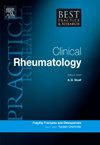New and future therapies: Changes in the therapeutic armamentarium for SLE
IF 4.5
2区 医学
Q1 RHEUMATOLOGY
Best Practice & Research in Clinical Rheumatology
Pub Date : 2023-12-01
DOI:10.1016/j.berh.2023.101865
引用次数: 0
Abstract
Following better understanding of molecular pathways involved in the pathogenesis of Systemic lupus erythematosus (SLE), pharmaceutical companies have been investigating new targeted drugs for SLE. The purpose of this scoping review is to provide an updated view of the most promising targeted therapies currently in clinical development or recently approved for SLE treatment as well as of the most promising potential future therapeutic strategies in SLE.
In the past several years, two new drugs have been developed for lupus treatment along with an extended indication for belimumab. Anifrolumab, the anti-interferon medication, to treat non-renal lupus; voclosporin, a calcineurin inhibitor, for the treatment of lupus nephritis; and belimumab for lupus nephritis. More than 90 investigational drugs are currently in clinical development for SLE treatment, with various targets including inflammatory cytokines and their receptors, intracellular signaling, B cells or plasma cells, co-stimulation molecules, complement fractions, T cells, plasmacytoid dendritic cells as well as various other immunological targets of interest. Researchers are also actively engaged in the development of new therapeutic strategies, including the use of monoclonal antibodies in combination with bispecific monoclonal antibodies, nanobodies and nanoparticles, therapeutic vaccines, utilizing siRNA interference techniques, autologous hematopoietic stem-cell transplantation and Chimeric Antigens Receptor (CAR)-T cells.
The therapeutic management and prognosis of SLE have profoundly evolved with changes in the therapeutic armamentarium. With the broad pipeline of targeted treatments in clinical development and new treatment strategies in the future, current challenges are transitioning from the availability of new drugs to the selection of the most appropriate strategy at the patient level.
新的和未来的疗法:系统性红斑狼疮治疗手段的变化。
随着人们对系统性红斑狼疮(SLE)发病机制的分子途径有了更深入的了解,制药公司一直在研究治疗系统性红斑狼疮的新靶向药物。本范围综述的目的是对目前正在临床开发或最近获准用于系统性红斑狼疮治疗的最有前景的靶向疗法以及系统性红斑狼疮未来最有希望的潜在治疗策略提供最新的看法。在过去的几年里,有两种新药被开发出来用于狼疮的治疗,同时贝利木单抗的适应症也得到了延长。抗干扰素药物 Anifrolumab 用于治疗非肾性狼疮;钙神经蛋白抑制剂 voclosporin 用于治疗狼疮肾炎;贝利木单抗用于治疗狼疮肾炎。目前有 90 多种用于系统性红斑狼疮治疗的在研药物处于临床开发阶段,这些药物的靶点包括炎性细胞因子及其受体、细胞内信号传导、B 细胞或浆细胞、共刺激分子、补体组分、T 细胞、浆细胞树突状细胞以及其他各种感兴趣的免疫学靶点。研究人员还积极开发新的治疗策略,包括使用单克隆抗体与双特异性单克隆抗体、纳米抗体和纳米颗粒、治疗疫苗、利用 siRNA 干扰技术、自体造血干细胞移植和嵌合抗原受体 (CAR)-T 细胞。随着治疗手段的变化,系统性红斑狼疮的治疗管理和预后也发生了深刻的变化。随着大量靶向治疗药物进入临床开发阶段以及未来新的治疗策略的出现,目前的挑战正在从新药的供应过渡到如何为患者选择最合适的治疗策略。
本文章由计算机程序翻译,如有差异,请以英文原文为准。
求助全文
约1分钟内获得全文
求助全文
来源期刊
CiteScore
9.40
自引率
0.00%
发文量
43
审稿时长
27 days
期刊介绍:
Evidence-based updates of best clinical practice across the spectrum of musculoskeletal conditions.
Best Practice & Research: Clinical Rheumatology keeps the clinician or trainee informed of the latest developments and current recommended practice in the rapidly advancing fields of musculoskeletal conditions and science.
The series provides a continuous update of current clinical practice. It is a topical serial publication that covers the spectrum of musculoskeletal conditions in a 4-year cycle. Each topic-based issue contains around 200 pages of practical, evidence-based review articles, which integrate the results from the latest original research with current clinical practice and thinking to provide a continuous update.
Each issue follows a problem-orientated approach that focuses on the key questions to be addressed, clearly defining what is known and not known. The review articles seek to address the clinical issues of diagnosis, treatment and patient management. Management is described in practical terms so that it can be applied to the individual patient. The serial is aimed at the physician in both practice and training.

 求助内容:
求助内容: 应助结果提醒方式:
应助结果提醒方式:


